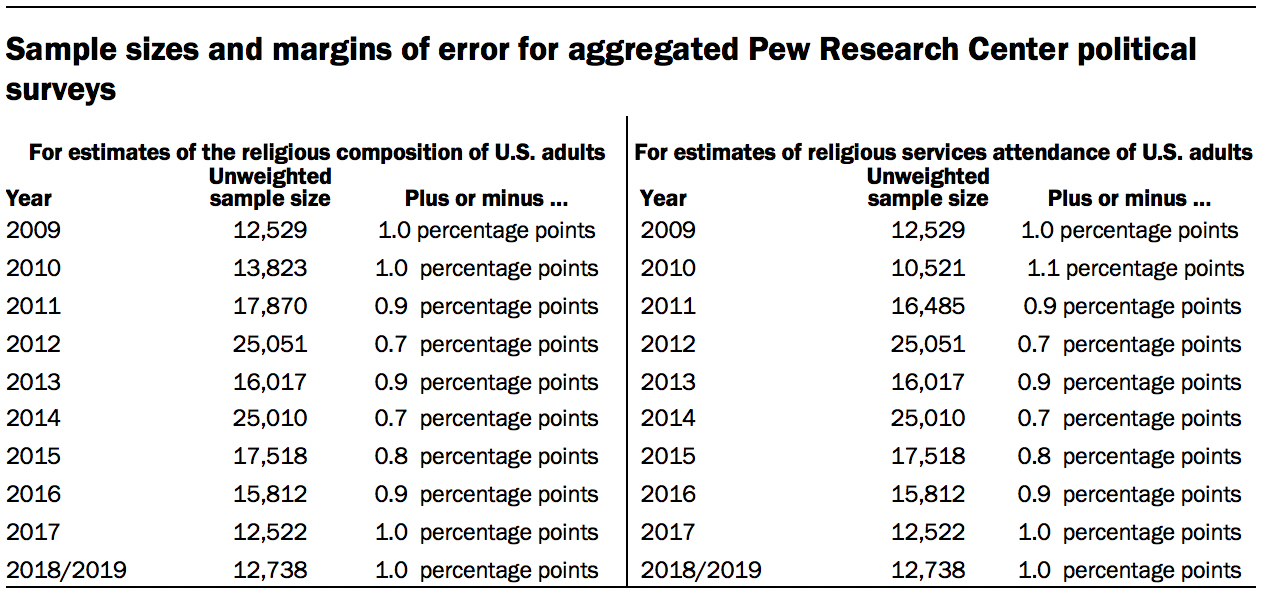Each year, Pew Research Center conducts several random-digit-dial (RDD) telephone (cellphones and landlines) surveys about political topics.6 Most of the analysis in this report is based on aggregated results from the complete set of those surveys conducted in each year beginning in 2009 and continuing through July of 2019; in total, the analysis includes interviews with 168,890 respondents who were interviewed in 88 separate surveys. Each survey was conducted in both English and Spanish by interviewers under the direction of one of three organizations: Abt Associates, Princeton Survey Research Associates International (PSRAI) or SSRS. The sampled telephone numbers for each survey were supplied either by Marketing Systems Group (MSG) or Dynata (formerly known as Survey Sampling International or SSI).
When interviewers reach someone on a landline phone, they randomly ask half the sample if they could speak with “the youngest male, 18 years of age or older, who is now at home” and the other half of the sample to speak with “the youngest female, 18 years of age or older, who is now at home.” If there is no eligible person of the requested gender currently at home, interviewers ask to speak with the youngest adult of the opposite gender, who is now at home. This method of selecting respondents within each household improves participation among young people who are often more difficult to interview than older people because of their lifestyles.
Unlike a landline phone, a cellphone is assumed to be a personal device in Pew Research Center polls. Interviewers ask if the person who answers the cellphone is 18 years of age or older to determine if the person is eligible to complete the survey (also see cellphone surveys for more information). This means that, for those in the cell sample, no effort is made to give other household members a chance to be interviewed. Although some people share cellphones, it is still uncertain whether the benefits of sampling among the users of a shared cellphone outweigh the disadvantages.
Nonresponse in telephone interview surveys can produce biases in survey-derived estimates. Survey participation tends to vary for different subgroups of the population, and these subgroups also are likely to vary on questions of substantive interest. To compensate for these known biases, the sample data are weighted for analysis.
The landline sample is first weighted by household size to account for the fact that people in larger households have a lower probability of being selected. In addition, the combined landline and cellphone sample is weighted to account for the fact that respondents with both a landline and cellphone have a greater probability of being included in the sample.
The sample is then weighted using population parameters for adults 18 years of age or older from the U.S. Census Bureau. The population parameters used for weighting are: gender by age; gender by education; age by education; region; race and Hispanic origin, which includes a break for Hispanics based on whether they were born in the U.S.; population density; and, among non-Hispanic whites, age, education and region. The parameters for these variables are from the Census Bureau’s American Community Survey (excluding those in institutionalized group quarters), except for the parameter for population density, which is from the decennial census. These population parameters are compared with the sample characteristics to construct the weights. In addition to the demographic parameters, the sample is also weighted to match current patterns of telephone status (landline only, cellphone only or both landline and cellphone), based on extrapolations from the National Health Interview Survey. The final weights are derived using an iterative technique that simultaneously balances the distributions of all weighting parameters.
Additional information on the methods Pew Research Center employs in conducting RDD telephone surveys is available here.
The question about religious identity that is included in Pew Research Center’s telephone surveys (and on which this analysis is based) is worded as follows: “What is your present religion, if any? Are you Protestant, Roman Catholic, Mormon, Orthodox such as Greek or Russian Orthodox, Jewish, Muslim, Buddhist, Hindu, atheist, agnostic, something else, or nothing in particular?”
The question about religious attendance that is included in Pew Research Center’s telephone surveys (and on which this analysis is based) is worded as follows: “Aside from weddings and funerals, how often do you attend religious services? More than once a week, once a week, once or twice a month, a few times a year, seldom, or never?”
The accompanying table includes information about the number of interviews conducted in each year and reports corresponding margins of error for the estimates based on the full sample for each year.

In addition to the analysis of aggregated Pew Research Center political polls, this report also includes some discussion of the results of Pew Research Center’s 2007 and 2014 Religious Landscape Studies (RLS). Complete details about those studies, including methodology, are available in “U.S. Public Becoming Less Religious” (2014) and “U.S. Religious Landscape Survey – Religious Beliefs and Practices: Diverse and Politically Relevant” (2007).




